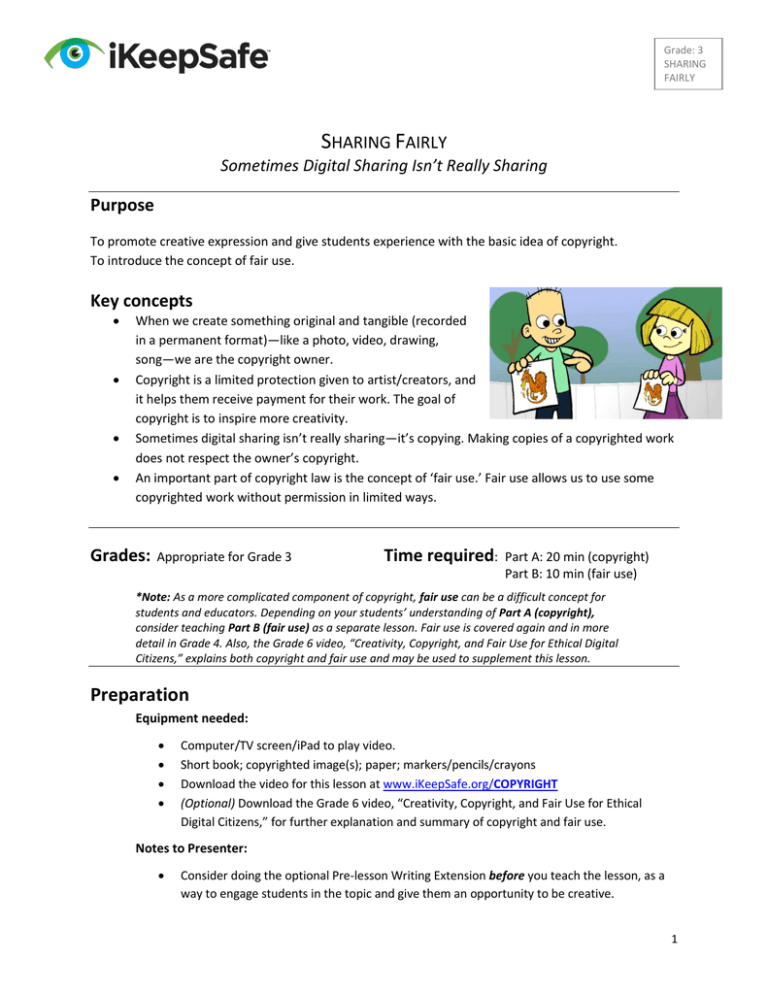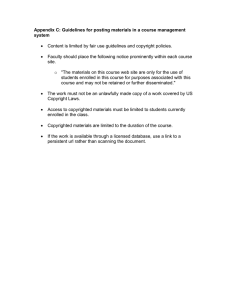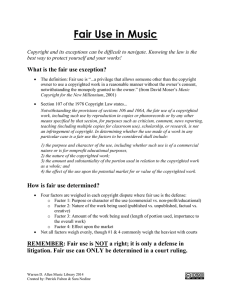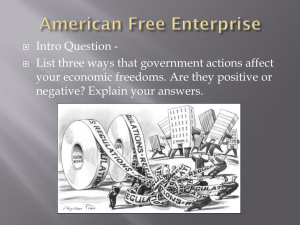
Grade: 3
SHARING
FAIRLY
SHARING FAIRLY
Sometimes Digital Sharing Isn’t Really Sharing
Purpose
To promote creative expression and give students experience with the basic idea of copyright.
To introduce the concept of fair use.
Key concepts
When we create something original and tangible (recorded
in a permanent format)—like a photo, video, drawing,
song—we are the copyright owner.
Copyright is a limited protection given to artist/creators, and
it helps them receive payment for their work. The goal of
copyright is to inspire more creativity.
Sometimes digital sharing isn’t really sharing—it’s copying. Making copies of a copyrighted work
does not respect the owner’s copyright.
An important part of copyright law is the concept of ‘fair use.’ Fair use allows us to use some
copyrighted work without permission in limited ways.
Grades:
Appropriate for Grade 3
Time required:
Part A: 20 min (copyright)
Part B: 10 min (fair use)
*Note: As a more complicated component of copyright, fair use can be a difficult concept for
students and educators. Depending on your students’ understanding of Part A (copyright),
consider teaching Part B (fair use) as a separate lesson. Fair use is covered again and in more
detail in Grade 4. Also, the Grade 6 video, “Creativity, Copyright, and Fair Use for Ethical Digital
Citizens,” explains both copyright and fair use and may be used to supplement this lesson.
Preparation
Equipment needed:
Computer/TV screen/iPad to play video.
Short book; copyrighted image(s); paper; markers/pencils/crayons
Download the video for this lesson at www.iKeepSafe.org/COPYRIGHT
(Optional) Download the Grade 6 video, “Creativity, Copyright, and Fair Use for Ethical
Digital Citizens,” for further explanation and summary of copyright and fair use.
Notes to Presenter:
Consider doing the optional Pre-lesson Writing Extension before you teach the lesson, as a
way to engage students in the topic and give them an opportunity to be creative.
1
This lesson features several activities you may want to integrate into existing curriculum
throughout the year. Consider including a short discussion of copyright and/or fair use
whenever students begin any creative or research project.
For more ways to talk about copyright, fair use, and related concepts of ethical digital
citizenship, see Presenter Instructions, “Integrating Copyright and Ethical Use Concepts into
Current Curriculum.”
Fair Use is a legal doctrine that is decided on a case-by-case basis and can be difficult to
determine. The following resources will enhance your understanding of fair use:
o US Copyright Office FAQ sheet: http://www.copyright.gov/help/faq/faqfairuse.html
o US Copyright Office on fair use: http://www.copyright.gov/fls/fl102.html
o VIDEO: Stanford University, Center for Internet & Society: "CIS Fair Use Legal
Experts Answer Fair Use Questions,” here:
https://www.youtube.com/watch?v=S521VcjhvMA&feature=youtu.be
o WEBSITE: Stanford University, Center for Internet & Society, here:
http://cyberlaw.stanford.edu/focus-areas/copyright-and-fair-use
o WEBSITE: Cornell Law School website, here:
http://www.law.cornell.edu/uscode/text/17/106
Teaching “Educational Fair Use”
As we try to simplify fair use for students, we have used the short hand of saying kids may
use content they "need" for educational purposes. We want to make sure that our studentcentered lesson does not undermine what we know are rules for educators when using
content in curricular materials. In most cases, the fair use analysis is likely to be different for
educators, and you have to consider multiple factors before making copies of content for a
class you teach. For example:
o Why are you using the work? What is your purpose and type of use you are making?
In particular, is your use transformative?
o Is the amount you used appropriate and reasonable in light of your purpose? If yes,
this will help your fair use claim.
o Even if you've only used a small portion, have you taken and used the “heart” of the
work? This will hurt your fair use claim.
o Will your use substitute for the original in the marketplace? (eg, making copies of
text books for students.) Even if it’s not a substitute, will it occupy markets that the
copyright owner is entitled to (eg, markets for sequels and other derivative works)?
This will hurt your fair use claim.
2
Pre-lesson Writing Extension (Optional)*
The following writing exercises are designed to create context, help students engage with the topic, and
prepare them for the lesson discussion.
A day or two before teaching this lesson, or as an introduction to this lesson, have students watch the
one-minute companion video and complete one of the writing exercises below.
OPTION 1: Write a Character Sketch
Play video for students: “SHARING FAIRLY: Sometimes Digital Sharing Isn’t Really Sharing”
(www.iKeepSafe.org/COPYRIGHT). You may need to play it 2 -3 times. Ask students to write a character
sketch about one of the characters in the video.
Be as creative as you can. There are no wrong answers. Give these characters a life of their own—
whatever you want it to be.
Prompt with questions:
Who is your character?
What is his/her name?
Who are his/her friends? How long have they known each other?
Who are the people in his/her family? What are they like?
What’s his/her backstory?
o Where does he/she live?
o Where did he/she used to live?
o What exciting thing might have happened to them back in kindergarten, first grade,
etc.?
What is he/she looking forward to?
What is he/she afraid of?
OPTION 2: Write a Story
Play video for students, “SHARING FAIRLY: Sometimes Digital Sharing Isn’t Really Sharing”
(www.iKeepSafe.org/COPYRIGHT). Ask students to write the story they see portrayed in the video.
Give your story a beginning, a middle, and an end. Use your creativity. Make it interesting.
Prompt with questions:
Who are the main characters? What are their names?
Give setting: Be specific and add to what you see.
o Where are they? Where do they go to school?
o What are they doing?
What is happening here?
How do the characters feel about it?
How does this story end?
* NOTE: These exercises may also be done orally as a class discussion before the copyright lesson.
Write the story or character sketch on the board as students contribute ideas.
3
Review (Optional)
If time permits, consider showing some or all of the K-2 videos and have a brief discussion about the concepts
that each of these videos teaches.
For example: “This week we are learning about copyright. Look what the [first graders] are learning.
Show videos:
Kindergarten: “Respect the Person”—Two friends learn the importance of respecting names on
artwork (attribution).
Grade 1: “It’s Great to Create”—Two friends discover the fun and benefit of creative collaboration.
Grade 2: “Creativity and Sharing Fairly”—A child decides how her photographs will be shared.
Lesson: Part A—Copyright
ACTIVITY
Show a book to the class. Let them see the copyright information and symbol in the front of the book.
Discuss what copyright means.
Copyright is a protection given to writers and creators to help them receive payment for their work. The
Supreme Court has called copyright "an engine of free expression,” because it’s an incentive for authors and
creators to devote time and money to producing new works. When artists, writers and other creators know
their work will be protected by copyright, they are encouraged to create more wonderful works for us to
enjoy.
If I write a book or make a movie or draw a picture, I can sell it and get paid. Copyright law protects my book
or movie or picture, so someone else can’t take it, make copies, and sell it without paying me.
The copyright symbol (©) is a reminder that the book is protected by copyright law.
All original work is copyrighted even if there is no symbol.
[Show a few images (art or photography) with the copyright symbol.]
[Show a few images (art or photography) without the copyright symbol.]
When you create something original and tangible, such as a drawing, original writing, a video, photograph,
song lyrics and music, or even a computer program, you are the copyright owner.
[Note: Help students understand that “tangible” means something recorded in a permanent format,
something that you can see, feel, touch, or use—an idea floating around in your head can’t be
copyrighted.]
OPTIONAL: PLAY VIDEO first half only (0:00 – 1:28)—Grade 6:“Creativity, Copyright, and Fair Use for Ethical
Digital Citizens.” This video explains how copyright works.
SUMMARY: Video explains the concepts of copyright and fair use and how they work together to
encourage more creative work:
4
Copyright (0:00 – 1:28) Students learn why copyright matters to themselves and the
artists they care about and shows one real-life situation where an artist is affected
by illegal sharing.
Fair Use (1:29 – 3:58) Legal concept of ‘fair use’ is introduced to explain that
copyright protected work can be used and shared without permission in certain,
limited ways that are still fair to the copyright owner.
Ask students to make their own work of art [or use an art project they’ve already completed.]
When they are finished, show students how to draw a copyright symbol with the year.
When you make something creative like this, it’s automatically protected by copyright even without the
copyright symbol.
Do you like to share the things you create?
[Yes/no. Take responses.]
How do you want your work shared with others?
[Give as a present, take a picture and post online, print a picture and give it to a friend, etc.—all of
these are sharing.]
How does it feel to be the one to decide how you want to share your work with others?
[Accept responses.]
What do you like to share online?
[Music, images, text, video, photographs, etc.]
What kinds of creative work do you make or share digitally?
[Accept responses.]
Is it fair to share others’ creative work this way?
[Accept responses. Yes or no, depending on what the author/artist decided.]
Demonstrate the following by handing a book to a student:
Sharing a digital file is different from face-to-face sharing. If I hand you my book to share it with you, you
have the book and I don’t—that’s sharing. If I hand you my iPod, so you can listen to my music, that is
sharing. If I share a digital file with you—like a song or a movie or computer game—we both end up with the
file. In that case, we made a copy. If I copy my songs for you to put on your iPod, that is not sharing—it’s
copying.
Let’s watch a short video about what can happen when we share work we don’t own. As you watch this
video, think about how you would feel if the situation happened to you. What would you do?
PLAY VIDEO: “SHARING FAIRLY: Sometimes Digital Sharing Isn’t Really Sharing”
(www.iKeepSafe.org/COPYRIGHT)
VIDEO SUMMARY: In this video, one student’s business (selling drawings on the playground) is foiled
when another student takes a picture of the drawings with a cell phone and makes copies.
5
DISCUSSION
What did you think of that?
[Accept responses.]
What was the result?
[Accept responses.]
Was that fair?
[Accept responses.]
How do you think you would feel if that happened to you?
[Accept responses.]
What would you have done if you were the one who wanted to share the dragon drawing? How
might the work have been shared in a fair way?
[By asking permission first. Accept responses.]
Do you think the boy in this story is going to want to bring more of his art to school to share or sell?
[Accept responses.]
Remember, the goal of copyright is to inspire more creative work. By giving owners/creators some
protection, they are encouraged to make more new creations.
Lesson: Part B—Fair Use
FAIR USE: Sometimes it’s fair to use copyrighted work without permission.
There are a few situations where we can use copyrighted work fairly without permission—we call these “fair
uses.” Fair use is an important part of copyright that helps us know when it’s legal and ethical to use
copyrighted work.
For example, as third graders, you are allowed to use copyright protected work if it’s for a school project.
Education is a fair use. If you need to show a movie clip or play a song with your PowerPoint® presentation
for a school project, that’s a fair use. However, if you want to have your brother put it up on YouTube, that
might not be fair, so you’ll need ask some other questions, such as: Who owns the song? Do I have
permission to publish it? (Explain: When you post something online, that’s publishing.)
There are also other fair uses, but the important thing for a third grader to remember is that fair use allows
you to use copyrighted work (original art, writing, dance steps, photographs, graphics, movies, sound
recordings, etc.)—legally and ethically—if it’s for school work. **
OPTIONAL: PLAY VIDEO second half only (1:29 – 3:58) if you have already shown the first half as part of this
lesson—Grade 6: “Creativity, Copyright, and Fair Use for Ethical Digital Citizens.” This video explains how
copyright and fair use work together to encourage more creative work.
OPTIONAL: Play Grade 6 video, second-half only (1:29 – 3:58) — “Creativity, Copyright, and Fair Use
for Ethical Digital Citizens.”
6
SUMMARY: This video explains the concepts of copyright and fair use and how they work
together to encourage more creative work:
Copyright (0:00 – 1:28) Students learn why copyright matters to themselves and the
artists they care about and shows one real-life situation where an artist is affected
by illegal sharing.
Fair Use (1:29 – 3:58) Legal concept of ‘fair use’ is introduced to explain that
copyright protected work can be used and shared without permission in certain,
limited ways that are still fair to the copyright owner.
** NOTE TO EDUCATORS: “Educational Fair Use”
As we try to simplify fair use for students, we have used the short hand of saying kids may use
content they "need" for educational purposes. We want to make sure that our studentcentered lesson does not undermine what we know are rules for educators when using
content in curricular materials. In most cases, the fair use analysis is likely to be different and
you have to consider multiple factors before making copies of content for a class you teach.
For example:
Why are you using the work? What is your purpose and type of use you are making?
In particular, is your use transformative?
Is the amount you used appropriate and reasonable in light of your purpose? If yes,
this will help your fair use claim.
Even if you've only used a small portion, have you taken and used the “heart” of the
work? This will hurt your fair use claim.
Will your use substitute for the original in the marketplace? (eg, making copies of
text books for students.) Even if it’s not a substitute, will it occupy markets that the
copyright owner is entitled to (eg. markets for sequels and other derivative works)?
This will hurt your fair use claim.
* For more information, see Presenter Instructions, “Integrating Copyright and Ethical Use
Concepts into Current Curriculum.”
Wrap-Up
When we make something creative (original writing, art, photographs, audio recordings, images, song lyrics—
even choreographed dance steps and computer games), copyright helps us protect how that art will be used
and shared by others. But there are times when we can use copyrighted work without permission: this is fair
use. We always want to be respectful with each other’s creations. Just because we own a copy of something
does not mean we have the right to make a copy and give it or sell it to other people.
NOTE:
The broader concepts of ethical digital sharing are covered in more detail in the Grade 4 lesson, and
may be appropriate to cover with your class, depending on their grasp of this lesson.
The more advanced concept of how to look at a copyright notice to determine if a digital file may be
shared is taught in the Grade 4 lesson, and may be appropriate for your class depending on their
grasp of and interest in this lesson.
© 2014 Internet Keep Safe Coalition (iKeepSafe). All rights reserved.
This product has been developed, copyrighted, and distributed for incidental, classroom use. Copies and reproductions of this content, in whole or in part, may be
distributed, reproduced or transmitted for incidental, classroom use only. Copyright language and distribution restrictions must be included on all reproductions whether
electronic or hard copy. Send legal inquiries to legal@ikeepsafe.org.
7
Dear Parent,
At school today we learned that sometimes digital sharing is not like the sharing we experience in the physical
world. Some digital sharing is actually “copying,” where a copy of a digital file is made—sound recording, video,
photo, drawing. This kind of sharing of copyrighted work does not respect the owner’s copyright. If you’re
interested, you can view the lesson here:
“SHARING FAIRLY: Sometimes Digital Sharing Isn’t Really Sharing
www.iKeepSafe.org/COPYRIGHT
We hope your child will continue to create and to understand how we all benefit when we respect each other's
work. This is one of the foundations of copyright and an important part of becoming an ethical digital citizen.
For fun and to reinforce this concept, you can do the following activity with your child:
Go on a “field trip” throughout your house. As you travel from room to room, point at different objects and
ask your child if they will share them with you. Start with objects that belong to your child (i.e backpack,
markers, stuffed animals, toys, etc). Say, “Hey, thanks for sharing.” [Or if they say no . . .] “OK, you get to
decide. You can choose to share or not share because you own it—it’s up to you to decide.” Then, ask if your
child will share other objects with you that aren’t hers to share (i.e a sibling’s backpack, the neighbor’s car,
etc.) Remind your child she actually can’t decide whether or not to share since it is not hers to give away. Talk
about how the same principles exist in the digital world.
Find more information about copyright and becoming a responsible digital citizen at: www.iKeepSafe.org/PARENT
Dear Parent,
At school today we learned that sometimes digital sharing is not like the sharing we experience in the physical
world. Some digital sharing is actually “copying,” where a copy of a digital file is made—sound recording, video,
photo, drawing. This kind of sharing of copyrighted work does not respect the owner’s copyright. If you’re
interested, you can view the lesson here:
“SHARING FAIRLY: Sometimes Digital Sharing Isn’t Really Sharing
www.iKeepSafe.org/COPYRIGHT
We hope your child will continue to create and to understand how we all benefit when we respect each other's
work. This is one of the foundations of copyright and an important part of becoming an ethical digital citizen.
For fun and to reinforce this concept, you can do the following activity with your child:
Go on a “field trip” throughout your house. As you travel from room to room, point at different objects and
ask your child if they will share them with you. Start with objects that belong to your child (i.e backpack,
markers, stuffed animals, toys, etc). Say, “Hey, thanks for sharing.” [Or if they say no . . .] “OK, you get to
decide. You can choose to share or not share because you own it—it’s up to you to decide.” Then, ask if your
child will share other objects with you that aren’t hers to share (i.e a sibling’s backpack, the neighbor’s car,
etc.) Remind your child she actually can’t decide whether or not to share since it is not hers to give away. Talk
about how the same principles exist in the digital world.
Find more information about copyright and becoming a responsible digital citizen at: www.iKeepSafe.org/PARENT
8




